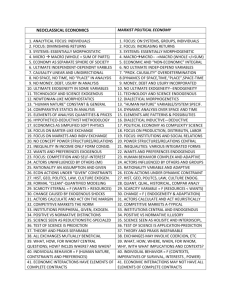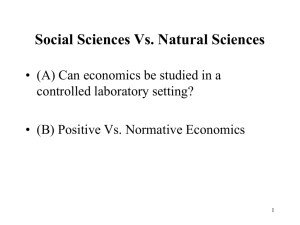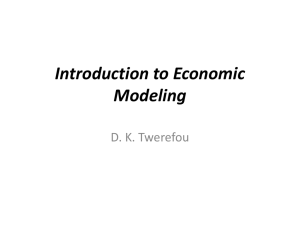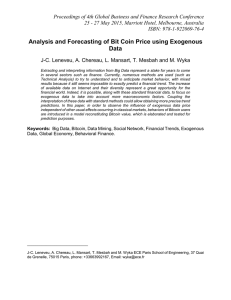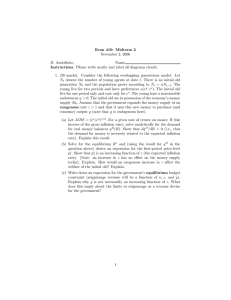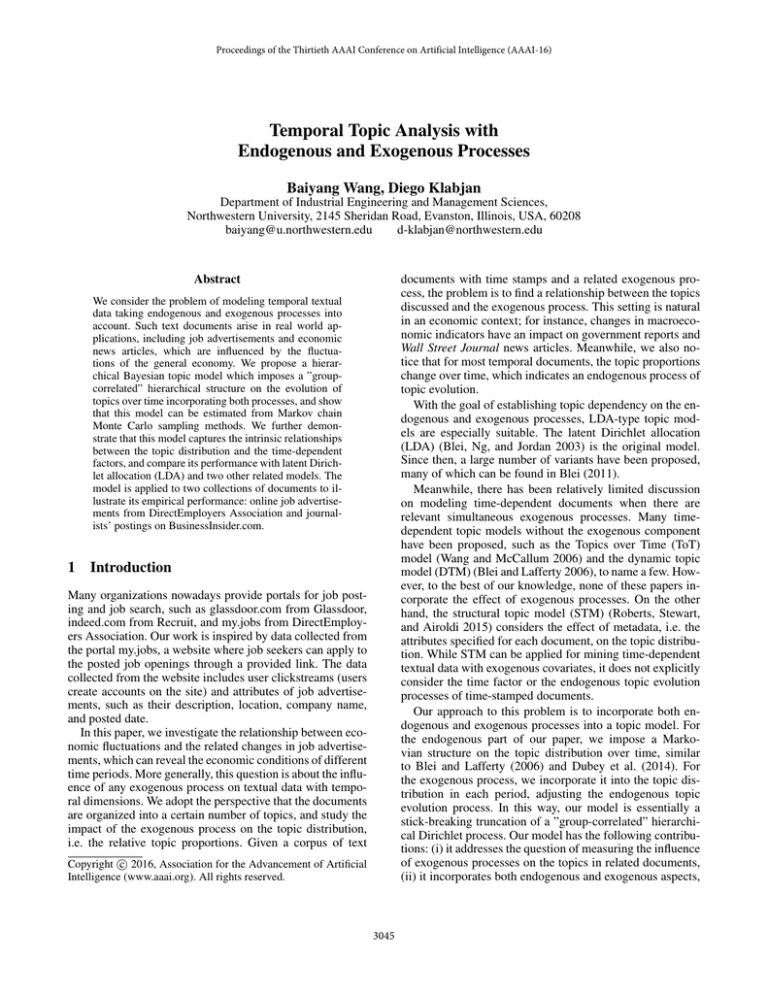
Proceedings of the Thirtieth AAAI Conference on Artificial Intelligence (AAAI-16)
Temporal Topic Analysis with
Endogenous and Exogenous Processes
Baiyang Wang, Diego Klabjan
Department of Industrial Engineering and Management Sciences,
Northwestern University, 2145 Sheridan Road, Evanston, Illinois, USA, 60208
baiyang@u.northwestern.edu
d-klabjan@northwestern.edu
documents with time stamps and a related exogenous process, the problem is to find a relationship between the topics
discussed and the exogenous process. This setting is natural
in an economic context; for instance, changes in macroeconomic indicators have an impact on government reports and
Wall Street Journal news articles. Meanwhile, we also notice that for most temporal documents, the topic proportions
change over time, which indicates an endogenous process of
topic evolution.
With the goal of establishing topic dependency on the endogenous and exogenous processes, LDA-type topic models are especially suitable. The latent Dirichlet allocation
(LDA) (Blei, Ng, and Jordan 2003) is the original model.
Since then, a large number of variants have been proposed,
many of which can be found in Blei (2011).
Meanwhile, there has been relatively limited discussion
on modeling time-dependent documents when there are
relevant simultaneous exogenous processes. Many timedependent topic models without the exogenous component
have been proposed, such as the Topics over Time (ToT)
model (Wang and McCallum 2006) and the dynamic topic
model (DTM) (Blei and Lafferty 2006), to name a few. However, to the best of our knowledge, none of these papers incorporate the effect of exogenous processes. On the other
hand, the structural topic model (STM) (Roberts, Stewart,
and Airoldi 2015) considers the effect of metadata, i.e. the
attributes specified for each document, on the topic distribution. While STM can be applied for mining time-dependent
textual data with exogenous covariates, it does not explicitly
consider the time factor or the endogenous topic evolution
processes of time-stamped documents.
Our approach to this problem is to incorporate both endogenous and exogenous processes into a topic model. For
the endogenous part of our paper, we impose a Markovian structure on the topic distribution over time, similar
to Blei and Lafferty (2006) and Dubey et al. (2014). For
the exogenous process, we incorporate it into the topic distribution in each period, adjusting the endogenous topic
evolution process. In this way, our model is essentially a
stick-breaking truncation of a ”group-correlated” hierarchical Dirichlet process. Our model has the following contributions: (i) it addresses the question of measuring the influence
of exogenous processes on the topics in related documents,
(ii) it incorporates both endogenous and exogenous aspects,
Abstract
We consider the problem of modeling temporal textual
data taking endogenous and exogenous processes into
account. Such text documents arise in real world applications, including job advertisements and economic
news articles, which are influenced by the fluctuations of the general economy. We propose a hierarchical Bayesian topic model which imposes a ”groupcorrelated” hierarchical structure on the evolution of
topics over time incorporating both processes, and show
that this model can be estimated from Markov chain
Monte Carlo sampling methods. We further demonstrate that this model captures the intrinsic relationships
between the topic distribution and the time-dependent
factors, and compare its performance with latent Dirichlet allocation (LDA) and two other related models. The
model is applied to two collections of documents to illustrate its empirical performance: online job advertisements from DirectEmployers Association and journalists’ postings on BusinessInsider.com.
1
Introduction
Many organizations nowadays provide portals for job posting and job search, such as glassdoor.com from Glassdoor,
indeed.com from Recruit, and my.jobs from DirectEmployers Association. Our work is inspired by data collected from
the portal my.jobs, a website where job seekers can apply to
the posted job openings through a provided link. The data
collected from the website includes user clickstreams (users
create accounts on the site) and attributes of job advertisements, such as their description, location, company name,
and posted date.
In this paper, we investigate the relationship between economic fluctuations and the related changes in job advertisements, which can reveal the economic conditions of different
time periods. More generally, this question is about the influence of any exogenous process on textual data with temporal dimensions. We adopt the perspective that the documents
are organized into a certain number of topics, and study the
impact of the exogenous process on the topic distribution,
i.e. the relative topic proportions. Given a corpus of text
c 2016, Association for the Advancement of Artificial
Copyright Intelligence (www.aaai.org). All rights reserved.
3045
Here i = 1, . . . , N , j = 1, . . . , Ji . The length-V random
vectors G0 , G1 , . . . , GN are “random word distributions,”
each of which is a draw from a Dirichlet process in (3).
Moreover, each draw from a random word distribution is
a length-V fixed vector φi,j ; it is the word distribution for
xi,j . The posterior inference can be achieved by different
strategies of Gibbs sampling.
There are mainly two approaches in the literature of measuring endogenous topic evolution processes. One approach
is to impose a finite mixture structure on the topic distribution: a dynamic hierarchical Dirichlet process (dHDP) (Ren,
Dunson, and Carin 2008) was proposed by adding a temporal dimension, and its variation was further applied on topic
modeling with a stick-breaking truncation of Dirichlet processes (Pruteanu-Malinici et al. 2010). The other approach
imposes a Markovian structure. For instance, the dynamic
topic model (DTM) (Blei and Lafferty 2006) is as follows,
and (iii) it demonstrates that text mining can also have useful implications in the realm of economics, which, from the
authors’ perspective, is a relatively new finding.
Section 2 offers a brief review on the topic modeling techniques related to our model. Section 3 develops our hierarchical Bayesian model and describes how to make posterior inferences with a variant of the Markov chain Monte
Carlo (MCMC) technique. Section 4 studies the online job
advertisements from DirectEmployers Association and journalists’ postings in finance on BusinessInsider.com with our
proposed method, providing a comparison of performance
with the standard LDA and STM. Section 5 suggests possible directions for the future and concludes the paper.
2
Review of Time-Dependent Topic Modeling
We first introduce the standard model of LDA (Blei, Ng, and
Jordan 2003). Suppose that there is a collection of docui
ments di , i = 1, . . . , N and words {xi,j }Jj=1
within each
document di indexed by a common dictionary containing V
words, where N is the number of documents, and Ji is the
number of words in di . The LDA model is as follows,
iid
iid
θ i ∼ Dir(α), φk ∼ Dir(β),
(1)
iid
zi,j |θ i ∼ Cat(θ i ), xi,j |zi,j ∼ Cat(φzi,j ).
⎧
2
⎪
⎪φt,k |φt−1,k ∼ N (φt−1,k , σ I),
⎪
⎪
2
⎪
⎪αt |αt−1 ∼ N (αt−1 , δ I),
⎨
iid
θ t,i |αt ∼ N (αt , a2 I),
⎪
⎪
iid
⎪
zt,i,j |θ t,i ∼ Cat(exp(θ t,i )),
⎪
⎪
⎪
⎩x |z
∼ Cat(exp(φ
)).
t,i,j
∞
bk δ ϕ k ,
t,zt,i,j
Here t = 1, . . . , T , i = 1, . . . , Nt , j = 1, . . . , Jt,i , k =
1, . . . , K (t ≥ 2 for the first two equations); T is the number of time periods, Nt is the number of documents in the
t-th period, and Jt,i is the number of words in the i-th document in the t-th period; the rest are similarly defined as
in LDA. One major difference between DTM and LDA is
that the topic distributions θ t,i and word distributions φt,k
are in log-scale in DTM. A variational Kalman filtering was
proposed for the posterior inference. As this Markovian approach is simpler for both interpretation and posterior inference, we apply a more generalized version of it to specify
the endogenous process in our model.
The structural topic model (STM) (Roberts, Stewart, and
Airoldi 2015) measures the effect of metadata of each document with the logistic normal distribution. Their model for
each document di is as follows,
Here i = 1, . . . , N , j = 1, . . . , Ji , k = 1, . . . , K; θ i is
the length-K per-document topic distribution for di , φk is
the length-V per-topic word distribution for the k-th topic,
zij is the topic for the j-th word in di , and K is the number of topics. Dir(·) denotes the Dirichlet distribution and
Cat(·) denotes the categorical distribution, a special case of
the multinomial distribution when nobs = 1.
The Dirichlet process is a class of randomized probability measures and can be applied for non-parametric modeling of mixture models. Denoting the concentration parameter by α and the mean probability measure by H, a realization G from the Dirichlet process can be written as
G ∼ DP (γ, H). With the stick-breaking notation (Sethuraman 1994), we have
G=
t,i,j
(4)
⎧
⎪
⎨θ i |(Xi γ, Σ) ∼ LogisticN ormal(Xi γ, Σ),
p(φi,k ) ∝ exp(m + κk + κgi + κkgi ),
⎪
⎩z |θ iid
∼ Cat(θ ), x |z ∼ Cat(φ
),
(2)
k=1
where δϕk is a “delta” probability measure with all the probk−1
iid
ability mass placed at ϕk , ϕk ∼ H, bk = bk i=1 (1 −
i,j
i
i
i,j
i,j
(5)
i,zi,j
iid
bi ), bk ∼ Beta(1, γ), k = 1, 2, · · · . We write b =
(b1 , b2 , . . .) ∼ Stick(γ). More properties of the Dirichlet
process can be found in Ferguson (1973).
A hierarchical Dirichlet process (HDP) was proposed in
the context of text modeling by Teh et al. (2005). The following hierarchical structure is assumed,
⎧
⎪
⎨G0 |γ ∼ DP (γ, H),
iid
(3)
G1 , . . . , GN |(α, G) ∼ DP (α, G),
⎪
⎩
iid
φi,j |Gi ∼ Gi , xi,j ∼ Cat(φi,j ).
where i = 1, . . . , N , j = 1, . . . , Ji ; Xi is the metadata matrix, γ is a coefficient vector, Σ is the covariance matrix, φi,k
is the word distribution for di and the k-th topic, m is a baseline log-word distribution, κk , and κgi and κkgi are the topic,
group, and interaction effects; the rest are defined similarly
to LDA. This model explicitly considers exogenous factors,
and can be applied to find the relationship between topic
distributions and exogenous processes. Below we adopt a
slightly more general approach, incorporating both endogenous and exogenous factors.
3046
3
Here we set d(·, ·) = +∞ if the two probability measures have different supports; this necessitates that all periods share the same topics. Our intent is that the topics should remain the same to investigate their relationships with endogenous and exogenous processes; otherwise,
changes in topics can blur the relationships and possibly
result in overfitting.
We apply the total variation distance
d(p, q) = λ · |p − q|dμ with λ > 0, although many others
can also be applied and lead to, for instance, a log-normal
model in DTM, or a normal model (Dubey et al. 2014;
Zhang, Kim, and Xing 2015). We have the following,
∞
⎧
⎨Gt = k=1 πtk δφk ,
(10)
π = πt−1 k + Lap(λ),
⎩ tk
π t = (πt1 , πt2 , . . .).
Model and Algorithm
3.1
Motivation: A Group-Correlated Hierarchical
Dirichlet Process
We formulate our problem as follows: we are given time
periods t = 1, . . . , T , documents from each period dt,i ,
i = 1, . . . , Nt , t = 1, . . . , T , and the indices of words
Jt,i
{xt,i,j }j=1
within each document dt,i from the first word
to the last. The words are indexed by a dictionary containing V words in total. We begin with a hierarchical Dirichlet
process in time 1: let G1 |γ ∼ DP (γ, H), G1i |(α1 , G1 ) ∼
DP (α1 , G1 ), where G1 is a baseline random word distribution for time 1, and G1i is the random word distribution
for document d1i . For G2 , . . . GT , we have the following
Markovian structure,
p(Gt )|Gt−1 ∝ exp[−d(Gt , Gt−1 )], t = 2, . . . , T.
Here t = 2, . . . , T , k = 1, 2, . . ., and Lap(λ) denotes
a Laplacian distribution with scale parameter λ. For the
exogenous part, we consider specifying the relationship
t =
t = (
πt1 , π
t2 , . . .) such that G
between π t and π
∞
∞
π
δ
,
G
=
θ
δ
.
We
let
t,i
k=1 tk φk
k=1 t,i,k φk
(6)
Here d(·, ·) is some distance between two probability measures. This completes our endogenous process. To take an
exogenous process {y t }Tt=1 into account, we assume the following
t = M(Gt , y t ), t = 1, . . . , T,
G
(7)
t = π t + η · y t , t = 1, . . . , T, 1 · η = 0.
π
Here η is a K × p matrix which indicates the relation t and the length-p vecship between the topic distribution π
t and π t are of infitor y t . However, we notice that π
nite length, which creates difficulty in our inference. Therefore we adopt a stick-breaking truncation approach, i.e.
we only consider {φk }K
k=1 in our model; the probability
weights for {φk }∞
k=K+1 in π t will be added into πtK . We
note that a number of papers in topic modeling have put
this approach into practice (Pruteanu-Malinici et al. 2010;
Wang, Paisley, and Blei 2011).
It has been shown (Pruteanu-Malinici et al. 2010) that
when the truncation level K is large, we may as well replace
the distribution of π 1 with π 1 ∼ Dir(γπ 0 ), where γ = 1,
π 0 = (1/K, . . . , 1/K). We also let H = Dir(β, . . . , β) as
in the paper by Teh et al. (2005). We summarize our model,
⎧
iid
⎪
φ1 , . . . , φK ∼ Dir(β, . . . , β),
⎪
⎪
⎪
⎪
⎪
⎨π 1 ∼ Dir(γπ 0 ), πtk = πt−1 k + Lap(λ),
t = πt + η · yt ,
π
(12)
⎪
iid
⎪
⎪
θ
|(α
,
π
)
∼
Dir(α
),
π
⎪
t,i
t
t
t t
⎪
⎪
iid
⎩
zt,i,j |θt,i ∼ Cat(θ t,i ), xt,i,j ∼ Cat(φzt,i,j ).
where M maps the endogenous baseline random word distribution Gt to the realized baseline random word distribu t for time t, considering the influence of {y t }T .
tion G
t=1
Therefore, we further assume that each per-document ran t rather
dom word distribution Gt,i is sampled with mean G
than Gt . The final model is as follows,
⎧
⎪
G |γ ∼ DP (γ, H),
⎪
⎪ 1
⎪
⎪
⎪
⎨p(Gt )|Gt−1 ∝ exp[−d(Gt , Gt−1 )],
t = M(Gt , y t ),
G
(8)
⎪
iid
⎪
⎪Gt,i |(αt , Gt ) ∼ DP (αt , Gt ),
⎪
⎪
⎪
⎩φ |G iid
∼G , x
∼ Cat(φ ).
t,i,j
t,i
t,i
t,i,j
t,i,j
Here t = 1, . . . , T , i = 1, . . . , Nt , j = 1, . . . , Jt,i (t ≥ 2 for
the first line). Throughout this paper, our model is fully conditional on {y t }Tt=1 , i.e. we assume {y t }Tt=1 to be fixed; this
has an intuitive explanation, as our temporal documents represent a very small portion of the underlying environment,
i.e. the exogenous process, so their influence on {y t }Tt=1 is
almost negligible.
3.2
(11)
Here t = 1, . . . , T , i = 1, . . . , Nt , j = 1, . . . , Jt,i (t ≥ 2 for
the second line). The last two lines above are derived as in
Teh et al. (2005). We note that here φk is the per-topic word
distribution, θ t,i is the per-document topic distribution, and
zt,i,j is the actual topic for each word; they have the same
meaning as in LDA.
We name our model a “group-correlated temporal topic
model” (GCLDA). Here a “group” stands for all the documents within the same time period. We use the term ”correlated” because the baseline topic distributions {π t }Tt=1 for
each period, controlling for {y t }Tt=1 , are endogenously correlated; meanwhile, the realized baseline topic distributions
{
π t }Tt=1 for each period are also correlated with the given
exogenous process {y t }Tt=1 .
A Group-Correlated Temporal Topic Model:
Stick-Breaking Truncation
Below we consider a stick-breaking truncation of the model
above, since posterior inference of the exact model can be
intricate. With the stick-breaking expression of G1 in (8),
we have
⎧
iid
⎪
⎨φ1 , φ2 , . . . , ∼ H,
(9)
π 1 = (π11 , π12 , . . .) ∼ Stick(γ),
⎪
⎩ G = ∞ π δ .
1
k=1 1k φk
3047
3.3
Sampling the posterior: An MCMC Approach
We note that (13) and (16) are full conditionals, and we can
easily derive the full conditionals of αt , πtk , and ηk from
(14) and (15). Since each zt,i,j |rest has a categorical distribution, and λ|rest has a Gamma distribution with a conjugate prior, they can be updated with Gibbs updates. For αt ,
πtk , and ηk , we replace a Gibbs update with a Metropolis
update. Specifically, suppose we know p(par|rest) up to a
multiplicative constant, where par is any length-1 parameter. We also assume par = par(r) at the r-th iteration. Then
at the (r + 1)-th iteration,
Direct estimation of the Bayesian posterior is often intractable since the closed-form expression, if it exists, can be
difficult to integrate and thus, many approaches to approximate the posterior have been proposed. Monte Carlo methods, which draw a large number of samples from the posterior as its approximation, are particularly helpful. In this paper, we adopt the Markov chain Monte Carlo (MCMC) approach which constructs samples from a Markov chain and
is asymptotically exact. Below we provide the Metropoliswithin-Gibbs sampling approach tailored to our situation,
which is a variant of the general MCMC approach. It only requires specifying the full conditionals of the unknown variables, which is covered below.
We consider sampling the following variables Z =
Jt,i Nt T
T
{zt,i,j }j=1
π t }Tt=1 , η, λ. We integrate
i=1 t=1 , {αt }t=1 , {
Nt T
out {θ t,i }i=1 t=1 and {φk }K
k=1 to speed up calculation. Following Griffiths and Steyvers (2004), conditioning on all
other variables listed for sampling,
parnew ∼ q(·|par(r) ),
parnew with prob. P,
par(r+1) =
par(r) with prob. 1 − P,
where P = min{p(parnew |rest)/p(par(r) |rest), 1}, and
q(·|·) is a known conditional probability distribution such
that q(x|y) = q(y|x).
This completes our sampling and posterior inference. For
the theoretical convergence properties of Metropolis-withinGibbs samplers, the reader can refer to Robert and Casella
(2004) and Roberts and Rosenthal (2006).
(−1)
(−1)
tk )
p(zt,i,j = k|rest) ∝ (Ct,i,k + αt π
Cxt,i,k ,k + β
(−1)
Ck
(17)
. (13)
+Vβ
(−1)
Here Ct,i,k is the count of elements in Z\{zt,i,j } which be-
4
(−1)
long to dt,i and has values equal to k; Cxt,i,k ,k is the count
of elements in Z\{zt,i,j } whose values are k and corre(−1)
is the count of elements
sponding words are xt,i,j ; Ck
in Z\{zt,i,j } whose values are k. Also following Griffiths
t
and Steyvers (2004), we have for αt and π
t |rest) ∝ p(Z|αt , π
t )p(π 1,...,T |γ, π 0 )p(αt )
p(αt , π
Nt Nt tk )
Γ(αt )
k Γ(Ct,i,k + αt π
∝
Γ(α
π
)
Γ(J
+
α
)
t tk
t,i
t
k
i=1
The proposed model, “GCLDA,” is demonstrated on two
data sets: (1) online job advertisements from my.jobs from
February to September in 2014, and (2) journalists’ postings
in 2014 in the “Finance” section in BusinessInsider.com,
an American business and technology news website. Our
algorithm has been implemented in Java, and we compare
GCLDA with LDA, ToT, and STM.
4.1
× exp [−λ (1t<T · πt+1 − πt 1 + 1t>1 · πt − πt−1 1 )]
(14)
× p(π 1 |γπ 0 )p(αt ).
(−1)
T
∝ exp −λ ·
T
iid
πt − πt−1 1
p(η).
(15)
t=2
Finally, for parameter λ, we have
p(λ|rest) ∝
T
p(π t |π t−1 , λ) · p(λ)
t=2
∝λ
(T −1)K
exp −λ ·
T
πt − πt−1 1
p(λ).
αt ∼ Γ(1, 1), p(η) ∝ e−0.01 |ηk | , λ ∼ Γ(1, 1), β = 0.01.
We carry out the Metropolis-within-Gibbs algorithm as described in Section 3.3 for GCLDA, and run 5,000 iterations of the Markov chain with 1,000 burn-in samples for
GCLDA, LDA, and ToT; for LDA, we apply the collapsed
Gibbs sampling as in Griffiths and Steyvers (2004). The
number of topics is set to K = 50 for both data sets. For
STM, we apply the “Spectral” initialization (Roberts, Stewart, and Tingley 2015) together with other default settings in
the R package stm. We perform data cleaning, remove the
stopwords, stem the documents, and keep most frequent V
words in each study. For the job advertisements, V = 2,000
and covers 96.2% of all words with repetition, which means
that the choice of words in job advertisements is quite narrow; for the journalists’ postings, V = 3,000 and covers
93.9% of all words with repetition.
p(π t |π t−1 , λ) · p(η)
t=2
Experiment Settings
We initialize the hyperparameters of LDA as follows: α =
(50/K, . . . , 50/K), β = (0.01, . . . , 0.01), according to a
rule of thumb which has been carried out in Berry and Kogan
(2010) and Sridhar (2015). For ToT, we use the same α and
β and linearly space the timestamps to make computation
feasible. For GCLDA, we let γ = 1, π 0 = (1/K, . . . , 1/K),
Here the difference between Ct,i,k and Ct,i,k is to replace
Z\{zt,i,j } with Z. We also view π t , πtk , etc. as functions
of the other parameters; specifically, πtk = π
tk − η k y t ,
where η k is the k-th row of η. This involves a transformation of variables; however, the related Jacobian determinant
det(J) = 1, so (14) is still valid. For parameter η, we have
p(η|rest) ∝
Case Studies
(16)
t=2
3048
The 20 most common topics are presented in Figure 2.
The only axis, the x-axis, represents the degree of correlation
ρ = η/π for all topics, i.e. the percent change in the topic
proportion given one unit change in the exogenous
covariate.
Here π and η denote the related component of π t /T and
η for each topic. Table 1 lists the highest probability words
sorted by their probabilities from high to low inside the five
topics with highest ρ in Figure 2.
We use perplexity to compare the difference of the prediction power between LDA, ToT, and GCLDA. The perplexity
for Ntest held-out documents given the training data D is
defined as
Ntest
i=1 log p(dtest,i |D)
perp = exp −
(18)
Ntest
i=1 ntest,i
where dtest,i represents the i-th held-out document, and
ntest,i is the number of words in dtest,i . We expect the perplexity to be small when a model performs well, since this
means that under the estimated model, the probability of a
word in the testing documents being written a priori is large.
We apply the “Left-to-right” algorithm (Wallach et al. 2009)
and apply point estimates for “Φ” and “αm” using the training data, as suggested in Section 3 in the same paper.
4.2
My.jobs: Online Job Advertisements
The number of online job advertisements on my.jobs from
February to September in 2014 amounts to 17,147,357 in
total, and the number of advertisements each day varies
greatly. Therefore, we gather a stratified sample of 44,660
advertisements with a roughly equal number of samples for
each day, so that we have sampled 0.26% of all the documents in total. The training data set consists of 40,449 advertisements, and the testing data set consists of 4,211 advertisements (9.4% of the sample). For the exogenous variable {y t }Tt=1 , we use the standardized Consumer Price Index from February to September in 2014, so that p = 1, and
T = 8.
Figure 1 implies that GCLDA better predicts the words
in the new documents in terms of perplexity. This is due to
the fact that the introduction of both endogenous and exogenous processes allows us to make more accurate inference
on the topic distributions of the documents in a given period
of time. The standard errors for the perplexity in each period
are also shown; we can observe that the difference is quite
significant.
Figure 2: The 20 most common topics and their ρ from
GCLDA for the job advertisements.
equal opportunity: employment status disabled veteran equal
health care: health care medical service provide center hospital
software: development experience software design application
secretarial: management operations ensure training perform
nursing: care nursing patient required clinical practice medical
Table 1: The highest probability words inside the five topics
with highest ρ in Figure 2.
A number of facts can be inferred from Figure 2. The
topics with positive ρ are those that have a positive correlation with the growth of the CPI in 2014. We can observe that two of them are supported by the U.S. government spending, namely “equal opportunity” and “health
care,” the latter of which is probably related to the Affordable Care Act programs. This suggests that there is
a causal relationship between the increase in government
spending and the increase in the number of jobs in these
categories, and the former was also an underlying factor in the growth of the CPI in 2014. We also observe
that “software” and “secretarial” were moving in the same
direction of CPI, while some traditional higher-paid job
categories, such as engineering and marketing, were not.
This partly agrees with some news articles in 2014 in that
while the labor market was recovering, there was relatively lower growth in traditional higher-paid job categories
(Lowrey 2014; Coy 2014).
Therefore, we posit that GCLDA could be helpful in identifying topics in temporal documents which are closely related to an exogenous process. The changes in the topic proportions may be caused by the exogenous process, or its
underlying factors, as is illustrated by this example, where
more demand of goods increases the CPI and creates more
jobs in certain categories. The other way around is also possible; changes in an exogenous process are caused by certain
kinds of news, as is demonstrated in the next example. Such
relationships require a more case-specific examination.
Figure 1: Perplexity results for the job advertisements from
February to September in 2014.
3049
We also compare our method with STM. Below is the
STM counterpart of Figure 2. We can observe that the topics
and correlation scores from GCLDA seem to be more timerelated and tend to be more informative of the labor market
during the period.
Again we observe that GCLDA generates a lower perplexity for the testing documents over time, therefore improving
the fitting of the topic model. Also, the perplexities obtained
from LDA and ToT are largely the same.
From Figure 5 and Table 2 below, the topics that are
strongly positively correlated with the VIX are generally
short-term news, such as stock market news and announcements from central banks, as in the topics “FED” (the Federal Reserve), “revenue,” and “stock market,” which are indeed closely related to changes in the stock market. From
our analysis, the drop in oil price and the instability in Russia and Ukraine were also major causes of fluctuations in the
stock market in 2014. On the other hand, we observe that
news about longer-term economic trends is not positively
correlated with the VIX, such as “companies” and “labor
market.” These are generally consistent with our understanding of the stock market.
In this example, we demonstrate an application of
GCLDA for finding documents that are major contributors
to changes in an exogenous process during a period of time.
We can easily estimate the topic distribution for each document, and therefore, we can select the news articles that are
mostly related to the stock market. Such a direction could
possibly evoke future research. We also note that in this example, the causal relationship between the topic distribution
and the stock market is bidirectional; news can change the
stock market, and vice versa.
Figure 3: The 20 most common topics and their γ from STM
for the job advertisements.
4.3
BusinessInsider.com: Financial News Articles
We consider all contributions in the “Finance” section of
BusinessInsider.com on all trading days in 2014. There are
15,659 articles in total, which are divided into a training
data set containing 12,527 articles and a testing data set containing 3,132 articles (20% of all articles). We increase the
proportion of testing documents and let T = 252 (all trading days) in order to create a more challenging scenario for
GCLDA. We apply the daily price of the Chicago Board
Options Exchange Market Volatility Index (VIX) as the exogenous process, measuring the volatility of the U.S. financial market. The other settings are the same as those in Section 4.2. We provide an analysis of the perplexity of LDA,
GCLDA, and ToT in Figure 4. The lines are smoothed by
LOESS with a span of 0.2, as there are large fluctuations in
perplexity from day to day.
Figure 5: The 20 most common topics and their ρ from
GCLDA for the financial articles.
FED: rate FED inflation policies market federal expected
revenue: quarter billion year revenue million earnings share
Ukraine: Russia Ukraine Moscow gas country president
stock market: market trade stock week day close morning
energy: oil price energies gas production crude supplies
Table 2: The highest probability words inside the five topics
with highest ρ in Figure 5.
We also compare our method with STM, with Figure 6
being the STM counterpart of Figure 5. Again we observe
that the topics and correlation scores from GCLDA seem
to be more time-related and tend to be more informative of
the stock market during the period. These findings assert our
view that GCLDA improves the structure of the topic model
and makes it more time-dependent.
Figure 4: Perplexity results for contributions in the “Finance” section in BusinessInsider.com in 2014.
3050
Ferguson, T. 1973. Bayesian analysis of some nonparametric problems. Annals of Statistics 1:209–230.
Griffiths, T., and Steyvers, M. 2004. Finding scientific
topics. Proceedings of the National Academy of Sciences
101:5228–5235.
Lowrey, A.
2014.
Recovery has created far more
low-wage jobs than better-paid ones. The New York Times.
www.nytimes.com/2014/04/28/business/economy/recoveryhas-created-far-more-low-wage-jobs-than-better-paidones.html.
Pruteanu-Malinici, I.; Ren, L.; Paisley, J.; Wang, E.; and
Carin, L. 2010. Hierarchical bayesian modeling of topics
in time-stamped documents. IEEE Trans. Pattern Analysis
Machine Intelligence 32:996–1011.
Ren, L.; Dunson, D.; and Carin, L. 2008. The dynamic hierarchical dirichlet process. In 25th International Conference
on Machine Learning.
Robert, C., and Casella, G. 2004. Monte Carlo Statistical
Methods. New York: Springer, 2nd ed. edition.
Roberts, G., and Rosenthal, J. 2006. Harris recurrence
of metropolis-within-gibbs and trans-dimensional markov
chains. The Annals of Applied Probability 16:2123–2139.
Roberts, M.; Stewart, B.; and Airoldi, E. 2015. A
model of text for experimentation in the social sciences.
scholar.harvard.edu/files/bstewart/files/stm.pdf.
Roberts, M.; Stewart, B.; and Tingley, D. 2015. Navigating
the local modes of big data: The case of topic models. In
Data Analytics in Social Science, Government, and Industry.
New York: Cambridge University Press. forthcoming.
Sethuraman, J. 1994. A constructive definition of dirichlet
priors. Statistica Sinica 4:639–650.
Sridhar, V. 2015. Unsupervised topic modeling for short
texts using distributed representations of words. In Proceedings of NAACL-HLT 2015.
Teh, Y.; Jordan, M.; Beal, M.; and Blei, D. 2005. Hierarchical dirichlet processes. Journal of the American Statistical
Association 101:1566–1582.
Wallach, H.; Murray, I.; Salakhutdinov, R.; and Mimno, D.
2009. Evaluation methods for topic models. In 26th International Conference on Machine Learning.
Wang, X., and McCallum, A. 2006. Topics over time: A
non-markov continuous-time model of topical trends. In
12th ACM SIGKDD International Conference on Knowledge Discovery and Data Mining.
Wang, C.; Paisley, J.; and Blei, D. 2011. Online variational
inference for the hierarchical dirichlet process. In Artificial
Intelligence and Statistics.
Zhang, H.; Kim, G.; and Xing, E. 2015. Dynamic topic
modeling for monitoring market competition from online
text and image data. In 21st ACM SIGKDD Conference on
knowledge Discovery and Data Mining.
Figure 6: The 20 most common topics and their γ from STM
for the financial articles.
5
Conclusion
We have developed a temporal topic model which analyzes
time-stamped text documents with known exogenous processes. Our new model, GCLDA, takes both endogenous and
exogenous processes into account, and applies Markov chain
Monte Carlo sampling for calibration. We have demonstrated that this model better fits temporal documents in
terms of perplexity, and extracts well information from job
advertisements and financial news articles. We suggest that a
possible direction for the future could be analyzing the contents of temporal documents so that they could predict the
trends of related exogenous processes.
Acknowledgments
This research was conducted in collaboration with the Workforce Science Project of the Searle Center for Law, Regulation and Economic Growth at Northwestern University. We
are indebted to Deborah Weiss, Director, Workforce Science
Project, for introducing us to the subject of workforce and
providing guidance. We are also very grateful for the help
and data from DirectEmployers Association.
References
Berry, M., and Kogan, J. 2010. Text Mining: Applications
and Theory. Chichester, UK: Wiley.
Blei, D., and Lafferty, J. 2006. Dynamic topic models. In
23rd International Conference on Machine Learning.
Blei, D.; Ng, A.; and Jordan, M. 2003. Latent dirichlet
allocation. Journal of Machine Learning Research 3:993–
1022.
Coy, P. 2014. America’s low-paying recovery: More
jobs than ever, worse wages.
Bloomberg Business.
www.bloomberg.com/bw/articles/2014-08-11/reportnew-jobs-in-u-dot-s-dot-offer-lower-wages-than-beforerecession.
Dubey, A.; Ho, Q.; Williamson, S.; and Xing, E. 2014. Dependent nonparametric trees for dynamic hierarchical clustering. In Advances in Neural Information Processing Systems 28. MIT Press.
3051

